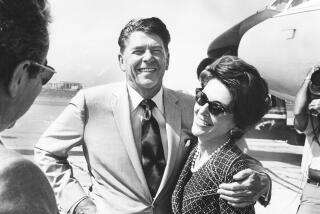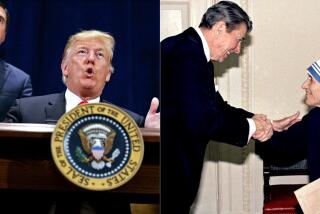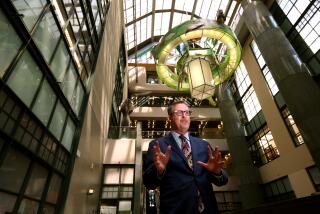Reagan Library Just Months From Opening : Memorial: The former President will give Britain’s ex-Prime Minister Margaret Thatcher a tour of the facility today.
Perched on a hilltop above Simi Valley, a massive and empty mission-style building stands nearly ready to chronicle Ronald Reagan’s presidency.
Over the next nine months, Reagan devotees will fashion a museum to immortalize the 40th President of the United States. The National Archives will deliver 40 truckloads of presidential papers and another 20 truckloads of gifts and memorabilia from Reagan’s eight years in the White House.
Reagan aides and supporters initially had hoped to complete the $60-million Ronald Reagan Presidential Library in time for the former President’s 80th birthday on Wednesday. And today, months before the scheduled November opening, Reagan will give former British Prime Minister Margaret Thatcher a personal tour of the complex.
On couches borrowed from Reagan’s office in Century City, the two former heads of state will have tea on the library’s yet-to-be-furnished second floor, aides say.
Weather permitting, their view from library windows could stretch to the Pacific Ocean and the Channel Islands 30 miles away.
“The President is proud of the library and wants to take her through it,” said Bill Garber, Reagan’s spokesman. Thatcher and her husband Denis have come to Southern California to attend Reagan’s birthday dinner on Wednesday at the Beverly Hilton Hotel.
Thatcher will address 900 or so guests expected at the dinner that the Reagans hope will raise as much as $2 million for the library. Guests will see videotaped messages from President Bush, Soviet President Mikhail S. Gorbachev and other world leaders.
Gov. Pete Wilson and Vice President Dan Quayle are also scheduled to attend but not speak. “If we let everybody who is notable speak, we’d be there for three days,” Garber said.
The Ronald Reagan Presidential Foundation has set a 10-year fund-raising goal of $75 million. The proceeds, Reagan aides say, should be enough to build the Reagan library--bigger and more expensive than any of its 10 predecessors with 153,000 square feet and a $60-million price tag. All of the initial costs will be covered by private donors.
The donations should be enough to launch the Ronald Reagan Center for Public Affairs, a conservative think tank that will occupy one small section of the four-floor library.
Garber said the foundation is more than halfway to its goal, although specific up-to-date totals are unavailable. Federal tax records obtained by The Times show that the foundation had raised $52.2 million from 1985 through 1989, with another $20 million in uncollected pledges.
Garber said IRS figures are misleading because they include the $14-million estimated value of 100 acres of undeveloped land donated as the library site. The price of the land was not included in fund-raising goals, he said, and actual cash donations collected through 1989 were $36.7 million.
Reagan’s staff declined to name donors, or specify how much was donated by Sony Corp. and other Japanese business interests. Eventually, contributors of $50,000 or more will have their names chiseled into a limestone wall in the library’s foyer, said Charles H. Jelloian, the foundation’s director of operations.
The Reagan foundation decided to build the library in the undeveloped hills of eastern Ventura County after abandoning a site at Stanford University that drew opposition from students, faculty members and nearby residents.
Located off Madera Road between Simi Valley and Thousand Oaks, the red-tiled building will house an estimated 54 million pages of White House documents and 30,000 gifts Reagan received during his eight years as President.
The four-level building, wrapped around a courtyard with olive trees and a fountain, includes four kitchens and a large multipurpose meeting room where movies could be screened and lectures and conferences held.
Furthest from completion is the 56,000-square-foot public museum. When completed, it will trace Reagan’s life from lifeguard to sports announcer, actor, governor of California and President. One gallery will be devoted to Nancy Reagan as First Lady.
The exhibits are still in the hands of museum designers in New York, and Reagan’s staff wants to keep most of the museum under wraps until closer to the opening. “We want to have surprises for people,” Jelloian said. “We have made it a policy not to let photographers inside.”
One section of the museum will contain an exact replica of the Oval Office, complete with the presidential seal on the ceiling and photographic reproductions of the views seen from the Oval Office windows.
To make it more authentic, the Reagan foundation has asked the White House for the carpet and desk that Bush pulled out of the Oval Office when he assumed the presidency.
“We are going to consider loaning the carpet,” said Rex Scouten, White House curator. But the desk is off-limits, he said, because Bush uses it in a residential wing of the White House.
Reagan aides say the arid beauty of the Simi Hills, with dramatic outcroppings of red rock, has worked out as an ideal setting for the Reagan library.
Not only does the terrain recall the dozens of movie Westerns shot on location in the hills; politically this is Reagan country too. The area voted overwhelmingly for Reagan for his two terms in office and is known for its blend of conservative politics and orderly suburban lifestyle.
More important, the site is located halfway between Reagan’s Bel-Air home and his ranch near Santa Barbara.
But building from scratch in an undeveloped section of Ventura County has driven up the cost of the project.
Although development firm Blakeley-Swartz donated the 100 acres, the Reagan foundation had to build a 400,000-gallon water tank just above the library grounds and cut a mile-long road, twisting up the hillside from Madera Road.
The former President, an experienced horseman, also installed a tunnel beneath the newly created Presidential Drive so the road would not block a longtime equestrian trail.
Jelloian stresses that the cost of the building alone remains at $40 million, the price quoted to donors. To keep costs down, he said, foundation officials switched from a parking garage to surface-level parking, crushed rock on the site instead of hauling it away and left the library’s stacks and storage rooms without drop ceilings.
Yet, unforeseen costs have cropped up, such as the electrified fence installed around the library grounds to keep deer from eating shrubbery and other plants.
The foundation has not yet determined the ultimate cost of the museum’s exhibits, Jelloian said. “When we talk about the overall project, we talk about a $60-million project,” Jelloian said.
As with most other presidential libraries, the Reagan foundation will hand over most of the building once it is completed to the National Archives and Records Administration so the federal agency can manage Reagan’s presidential papers and the museum. (Former President Richard M. Nixon decided to keep his presidential library in Yorba Linda in private hands to retain more control.)
In a joint-use agreement under negotiation, the foundation promises to pick up its share of utilities and maintenance for the second-floor suite of presidential offices and for the Ronald Reagan Center for Public Affairs on the lower level.
Reagan is the last former President who will be allowed to build a library privately and then expect the federal government to pay for its upkeep. In 1986, Congress grew concerned about the escalating size and cost of presidential libraries and passed a law requiring presidential foundations that build libraries to set up endowments to help maintain them.
At the time, White House aides argued that the bill should not apply to the sitting President, and Congress agreed to exempt Reagan. Since then, a few Democratic senators have called on Reagan to comply voluntarily with the law to save taxpayers money.
Jelloian said the Reagan foundation has no plans to establish an endowment to pick up annual maintenance costs estimated between $1.5 million and $3 million. “The last figure I saw was $3 million,” Jelloian said.
Reagan has no intention of closing his plush offices on the 34th floor of a high-rise building in Century City, aides said. As a former President, the U.S. Government provides him with a salary of $104,700 a year, a small personal staff and an office.
In the 1990 fiscal year, documents show, the government spent $592,426 on salary for Reagan, his staff, and other office expenses--the highest paid to any of the four living former Presidents.
More to Read
Sign up for Essential California
The most important California stories and recommendations in your inbox every morning.
You may occasionally receive promotional content from the Los Angeles Times.










